Punjabi festivals
Punjabi festivals are various festive celebrations observed by Punjabis in Pakistan, India and the diaspora Punjabi community found worldwide. The Punjabis area diverse group of people from different religious background that affects the festivals they observe. According to a 2007 estimate, the total population of Punjabi Muslims is about 90 million (~75% of all Punjabis), with 97% of Punjabis who live in Pakistan following Islam, in contrast to the remaining 30 million Punjabi Sikhs and Punjabi Hindus who predominantly live in India.[1]
| Part of a series on the |
| Punjabis |
|---|
 |
|
|
Asia
Europe North America |
|
Culture |
|
Punjab portal |
The Punjabi Muslims typically observe the Islamic festivals, do not observe Hindu or Sikh religious festivals, and in Pakistan the official holidays recognize only the Islamic festivals.[2][3] The Punjabi Sikhs and Hindus typically do not observe these, and instead observe historic festivals such as Lohri, Basant and Baisakhi as seasonal festivals.[4] The Sikh and Hindu festivals are regional official holidays in India, as are major Islamic festivals.[5] Other seasonal Punjabi festivals in India include Teejon (Teeyan) and Maghi.[4] Teeyan is also known as festival of womens as women's enjoy with their friends .On the day of maghi people fly kites and eat their traditional dish khichdi.
The Punjabi Muslim festivals are set according to the lunar Islamic calendar (Hijri), and the date falls earlier by 10 to 13 days from year to year.[6] The Hindu and Sikh Punjabi seasonal festivals are set on specific dates of the luni-solar Bikrami calendar or Punjabi calendar and the date of the festival also typically varies in the Gregorian calendar but stays within the same two Gregorian months.[7]
Some Punjabi Muslims participate in the traditional, seasonal festivals of the Punjab region: Baisakhi, Basant and to a minor scale Lohri, but this is controversial. Islamic clerics and some politicians have attempted to ban this participation because of the religious basis of the Punjabi festivals,[8] and they being declared haram (forbidden in Islam).[9]
Buddhist festivals
Punjabi Buddhists are a minority in Punjab, India.[10] In the Punjab province of Pakistan, the Buddhist population is negligible.[11]
Punjabi Buddhists celebrate festivals such as Buddha Jayanti.[12]
Christian Festivals
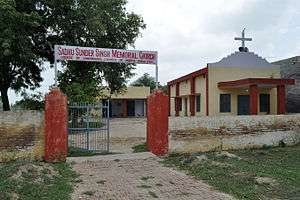
Christians are a minority in Pakistan, constituting about 2.3% of its population in contrast to 97.2% Muslims.[11] In Indian state of Punjab, Christians form about 1.1% of its total population, while the predominant majority of the population being Sikh and Hindus. Punjabi Christians celebrate Christmas to mark the birth of Jesus. In Punjab, Pakistan, people stay up late singing Punjabi Christmas carol services.[13] People attend churches in places such as Gurdaspur, Amritsar, Jalandhar and Hoshiarpur districts in Punjab, India that have a higher Christian population, to be part of Christmas celebrations.[14] Christians also celebrate Easter by engaging in processions.[15]
Hindu and Sikh festivals
Holi
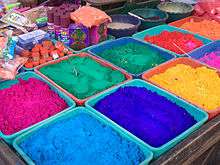
Holi is the spring Hindu festival of colours which is celebrated by throwing colours on each other.[16][17] The festival is celebrated on the first day of the Punjabi lunar month of Chet and marks the Spring season. The festival is primarily celebrated by Hindus. But Sikhs also participate in the festival which is seasonal in its significance and secular in its celebration.[18]
In the Indian state of Punjab, Holi is preceded by Holika Dahan the night before. On the day of Holi, people engage in throwing colours[19] on each other.[20]
During Holi in Punjab, walls and courtyards of rural houses are enhanced with drawings and paintings similar to rangoli in South India, mandana in Rajasthan, and rural arts in other parts of India. This art is known as chowk-poorana or chowkpurana in Punjab and is given shape by the peasant women of the state. In courtyards, this art is drawn using a piece of cloth. The art includes drawing tree motifs, flowers, ferns, creepers, plants, peacocks, palanquins, geometric patterns along with vertical, horizontal and oblique lines. These arts add to the festive atmosphere.[21]
Lohri
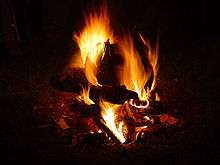
Lohri is a popular winter time Punjabi folk festival, celebrated primarily by Sikhs and Hindus from the Punjab region of Indian subcontinent.[22][23] According to Chauhan (1995), all Punjabis, including Muslims and Christians celebrate Lohri in Punjab, India.[24] Lohri is celebrated on the last day of the month of poh (January).[25]
Many people believe the festival commemorates the passing of the winter solstice.[26][27][28] Lohri is observed the night before Makar Sankranti, also known as Maghi, and according to the solar part of the lunisolar Bikrami calendar and typically falls about the same date every year (January 13).[29]
Lohri is an official gazetted holiday in the state of Punjab (India),[30] but it is not a holiday in Punjab (Pakistan).[31] It is, however, observed by Sikhs and some Punjabi Muslims and Christians in Pakistan as well.[32]
Maghi
Maghi is a Sikh festival and one of their largest annual gatherings near Gurudwaras.[33] The same festival is called Makar Sankranti by Hindus, who gather near Hindu temples. The Magha Mela, according to Diana L. Eck – a professor at Harvard University specializing in Indology, is mentioned in the Hindu epic, the Mahabharata, thus placing this festival to be around 2,000 years old.[34] Many go to sacred rivers or lakes and bathe with thanksgiving to the sun.[34]
People visit the Gurdwara or the Mandir. The festival marks the increase in daylight.[35] Maghi is celebrated by people eating kheer such as Rauh di kheer which is an old dish where rice is cooked in sugarcane juice. The dish is prepared in the evening before Maghi and is kept to cool. It is served cold next morning on Maghi with red-chilly mixed curd.[36] In some parts of Punjab, India, it is also traditional to eat kichdi mixed with lentils, consume raw sugarcane and jaggery,[35] Fairs are held at many places on Maghi.[37] Sports festivals are also held in the region.
Basant Festival

Basant Festival is an ancient Hindu spring festival dedicated to god Kama as well as goddess Saraswati.[38] Its link with the Hindu god of love and its traditions have led some scholars to call it "a Hindu form of Valentine's Day".[39] The festival is also observed by Punjabi Sikhs.[40] The traditional colour of the day is yellow and the dish of the day is saffron rice. People fly kites.[38][41]
In North India, and in the Punjab province of Pakistan, Basant is celebrated as a spring festival of kites.[42] The festival marks the commencement of the spring season. In the Punjab region (including the Punjab province of Pakistan), Basant Panchami has been a long established tradition of flying kites[43] and holding fairs.
Punjabi Muslims have treated parts of the festival as a cultural event. In Pakistan however kite flying has been banned starting in 2007 with officials stating that it uses dangerous, life-threatening substances on the strings.[44] The festival ban was confirmed by the Pakistan Punjab state chief minister Shehbaz Sharif in 2017. According to some analysts, "the festival was banned due to pressure from hardline religious and extremist groups like the Hafiz Saeed-led Jamaat-ud Dawah, which claimed the festival had “Hindu origins” and was “un-Islamic”.[45]
Vaisakhi
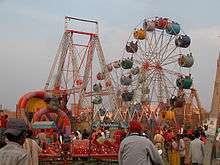
Vaisakhi is a religious festival of Sikhs and Hindus. Vaisakhi is also a harvest festival for people of the Punjab region.[46] In the Punjab, Vaisakhi marks the ripening of the rabi harvest.[35] Vaisakhi also marks the new year for Punjabi Sikhs and Hindus.[47][48] Punjabi Muslims observe the new year according to the Islamic calendar.
The harvest festival is celebrated by Punjabi Sikhs and Hindus.[49]
According to Aziz-ud-din Ahmed, Lahore used to have Baisakhi Mela after the harvesting of the wheat crop in April. However, adds Ahmed, the city started losing its cultural vibrancy in 1970s after Zia-ul-Haq came to power, and in recent years "the Pakistan Muslim League (N) government in Punjab banned kite flying through an official edict more under the pressure of those who want a puritanical version of Islam to be practiced in the name of religion than anything else".[50] Unlike the Indian state of Punjab that recognizes the Vaisakhi Sikh festival as an official holiday,[5] the festival is not an official holiday in Punjab or Sindh provinces of Pakistan where Islamic holidays are officially recognized instead.[2][3] However, On 8 April 2016, Punjabi Parchar at Alhamra (Lahore) organised a show called Visakhi mela, where the speakers pledged to "continue our struggle to keep the Punjabi culture alive" in Pakistan through events such as Visakhi Mela.[51] Elsewhere Besakhi fairs or melas are held in various places including Eminabad[52] and Dera Ghazi Khan.[53][note 1]
Teeyan
Teeyan welcomes the monsoon season and the festival officially starts of the day of Teej and last for 13 days. The seasonal festival involves women and girls dancing Gidha and visiting family. The festival is observed in Punjab, India.
The festival is celebrated during the monsoon season from the third day of the lunar month of Sawan on the bright half, up to the full moon of sawan, by women. Married women go to their maternal house to participate in the festivities.[57][58] In the past, it was traditional for women to spend the whole month of Sawan with their parents.[57][59]
Teej is historically a Hindu festival, dedicated to Goddess Parvati and her union with Lord Shiva, one observed in northern, western, central and Himalayan regions of the Indian subcontinent.[60][61]
Others
Other festivals observed by Punjabi Hindus and Sikhs include Diwali, Dussehra, Rama Navami, Bandi Chhor Divas and Gurpurabs. Raksha Bandhan in the Punjab is known as 'Rakhri' and is celebrated as a brothers and sisters day.
Muslim festivals
The following religious festivals are observed by Punjabi Muslims.
Eid ul-Adha
Eid ul-Adha is also known as Eid-ul-Azha. The festival is celebrated on the tenth day of the last Islamic month of Zilhij. Eid-ul-Azha occurs about two months after Eid-ul-Fitr. Eid-ul-Azha is celebrated to commemorate the occasion when the prophet Abraham was ready to sacrifice his son, Ismail, on God's command. Abraham was awarded by God by replacing Ismail with a goat. Muslims make pilgrimage (hajj) to Mecca during this time.[62]
Animal sacrifice is a tradition offered by Muslims on this day.[63] Special markets are set up to deal with the increase in demand of animals. Cattle markets are set up in places such as Multan, (Punjab, Pakistan)[64] and goat markets in Ludhiana,[65] (Punjab, India). The children celebrate Eid ul-Adha and Eid ul-Fitr with great pump and show and receive gifts and Eidi (money) from parents and others.[66]
Eid-ul-Fitr
Eid al-Fitr takes place on the first day of the tenth month of the Islamic lunar calendar and celebrates the end of Ramadan. Ramadan is the time of fasting that continues throughout the ninth month.[67] On this day, after a month of fasting, Muslims express their joy and happiness by offering a congregational prayer in the mosques. Special celebration meals are served.[68] The festival is celebrated in Punjab, Pakistan. It is also celebrated in Malerkotla (Punjab, India) which has a sizable Muslim population where Sikhs and Hindus also participate in the observance.[69]
Eid-e-Milad-un-Nabi
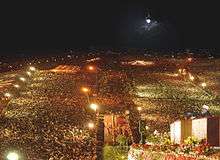
Eid-e-Milad-un- Nabi is an Islamic festival which is celebrated in honour of the birth-day of Prophet Muhammad.[70] The festival is observed in the third month of the Islamic lunar calendar called Rabi'al-Awal.[71] Various processions take place in Lahore to celebrate the festival.[72] According to Nestorovic (2016), hundreds of thousands of people gather at Minare-Pakistan, Lahore, between the intervening night of 11th and 12th Rabi' al-awwal of the Islamic calendar Eid Milad Dun Nabi.[73] The festival was declared a national holiday in Pakistan in 1949.[74]
People from various places in Punjab, Pakistan including Bahawalpur, Faisalabad, Multan and Sargodha participate in processions and engage in decorating Mosques, streets and houses with green flags and lights.[75] According to Khalid, children, teenagers and young adults decorate their Pahari (mountain) of all sorts of toys, including cars, stereos, and numerous other commodities. Within various places of Lahore, there are numerous stalls. Before the festival became a celebratory day, people used to celebrate the day quietly. However, the first procession to mark the day was led from Delhi gate in Lahore in 1935. This tradition then became popular elsewhere.[76] Processions are also taken out in Bathinda (Punjab, India).[77]
Muharram

Remembrance of Muharram is a set of rituals associated with Shia,[78] which takes place in Muharram, the first month of the Islamic calendar. Many of the events associated with the ritual take place in congregation halls known as Hussainia. The event marks the anniversary of the Battle of Karbala when Imam Hussein ibn Ali, the grandson of Muhammad, was killed by the forces of the second Umayyad caliph Yazid I at Karbala. Family members, accompanying Hussein ibn Ali, were killed or subjected to humiliation. The commemoration of the event during yearly mourning season, from first of Muharram to twentieth of Safar with Ashura comprising the focal date, serves to define Shia communal identity.[79]
In Pakistani Punjab, Muharram is celebrated twice, once according to the Muslim year and again on the 10th of harh.[80]
Processions

Traditionally, a white horse representing Ali's white Mule Duldul, is usually lead in the Muharram procession, as in Jhang, Punjab, Pakistan.[81] Zuljanah, Tazia and Alam processions are observed in many places in Punjab, Pakistan including Sialkot, Gujranwala, Bahawalnagar, Sargodha, Bahawalpur.[82] and Lahore.
Zuljana
Zuljanah processions are held which involves taking a replica of a horse. The Zuljanah has two wings and the processions were introduced from Iran to Lahore during the 19th century.[83]
Tazia
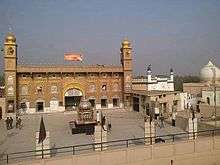
Shia Muslims take out a Tazia procession on the day of Ashura. [84] A Tazia is traditionally a bamboo and paper model of Hussain's tomb at Karbala, which is carried in procession by Shias on the tenth day of the month of Muharram.[85] Moderns forms of Tazia can be more elaborate. Tazia processions in Punjab are historic and were observed during the Sikh and British period when the Tazia would be divided into many storeys, but not ordinarily more than three.[86] Such processions take place in Lahore where mourners take to the streets to commemorate the sacrifices of Imam Hussain and his family in Karbala. Various stalls are set up offering milk, water and tea along the route of the processions. Some distribute juice packets, dry fruit, sweetmeats and food among mourners.[87] Tazia processions can also be seen in Malerkotla[88] and Delhi.[89]
Alam
Alam processions take place in Punjab, Pakistan too.[90] Alam is an elaborate, heavy battle standard, carried by a standard bearer, alam-dar, ahead of the procession. It represents Imam Hussain’s standard and is revered as a sacred object.[91]
Local festivals
Various local fairs and festivals are associated with particular shrines, temples and gurdwaras.
Mela Chiragan
Mela Chiraghan (Festival of Lights) is a three-day annual festival to mark the urs (death anniversary) of the Punjabi Sufi poet and saint Shah Hussain (1538-1599) who lived in Lahore in the 16th century. It takes place at the shrine of Shah Hussain in Baghbanpura, on the outskirts of Lahore, Pakistan, adjacent to the Shalimar Gardens.[92]
Rath Yatra Nabha
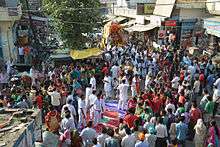
Rath Yatra Nabha, Ratha Jatra or Chariot Festival is a Hindu festival associated with the god Jagannath held at Mandir Thakur Shri Saty Narayan Ji in the Nabha City, state of Punjab, India. This annual festival is celebrated in the month of August or September. The festival is connected to Jagannath's visit to Nabha city.
Hola Mohalla
A fair is held at Anandpur Sahib (Punjab, India) during the lunar month of Chet to celebrate the Sikh festival of Hola Mohalla. The fair is held on a very large scale every year on the day following Holi. Thousands of devotees come from all parts of the country to pay their homage to Guru Gobind Singh.[93]
Notes
- Security concerns are another reason for the lack of holding fairs which lead to the Baisakhi mela in Gujranwala to mark wheat harvesting being cancelled in 2015.[54] Despite the bomb blast at the Sakhi Sarwar sufi shrine in Dera Ghazi Khan in 2011,[55] the Baisakhi mela around the water channel near the shrine that continues until the wheat harvest was integrated with the annual Urs of the saint in 2012.[56]
References
- Wade Davis; K. David Harrison; Catherine Herbert Howell (2007). Book of Peoples of the World: A Guide to Cultures. National Geographic. pp. 132–133. ISBN 978-1-4262-0238-4.
- Official Holidays 2016, Government of Punjab – Pakistan (2016)
- Official Holidays 2016 Archived 2018-09-01 at the Wayback Machine, Karachi Metropolitan, Sindh, Pakistan
- Census of India, 1961: Punjab. Manage of Publications
- Official Holidays, Government of Punjab, India (2016)
- Jacqueline Suthren Hirst; John Zavos (2013). Religious Traditions in Modern South Asia. Routledge. p. 274. ISBN 978-1-136-62668-5.;
Eid ul-Fitar, Ramzan Id/Eid-ul-Fitar in India, Festival Dates - Tej Bhatia (2013). Punjabi. Routledge. pp. 209–212. ISBN 978-1-136-89460-2.
- The ban on fun, IRFAN HUSAIN, Dawn, Feb 18, 2017
- The barricaded Muslim mind, Saba Naqvi (August 28, 2016), Quote: "Earlier, Muslim villagers would participate in Hindu festivals; now they think that would be haraam, so stay away. Visiting dargahs is also haraam"
- Jain, Harish (2003) Punjab Hand Book: Population and Housing Census. Unistar Books.
- POPULATION BY RELIGION, Pakistan Bureau of Statistics
- D. C. Ahir (1992) Dr. Ambedkar and Punjab. B.R. Publishing Corporation
- Sarfraz, Emanuel The Nation (25.12.2016) Understanding the changing face of Christmas .
- Hindustan Times (25.12.2015) Christmas celebrations held across Punjab, Haryana and Chandigarh
- The Tribune (10/04/2017)
- McKim Marriott (2006). John Stratton Hawley and Vasudha Narayanan (ed.). The Life of Hinduism. University of California Press. p. 102. ISBN 978-0-520-24914-1.
- The New Oxford Dictionary of English (1998) ISBN 0-19-861263-X - p.874 "Holi /'həʊli:/ noun a Hindu spring festival ..."
- Rait, S.K (2005) Sikh Women in England: Their Religious and Cultural Beliefs and Social Practices. Trentham Books.
- Parminder Singh Grover and Moga, Davinderjit Singh, Discover Punjab: Attractions of Punjab
- Jasbir Singh Khurana, Punjabiyat: The Cultural Heritage and Ethos of the People of Punjab, Hemkunt Publishers (P) Ltd, ISBN 978-81-7010-395-0
- Drawing Designs on Walls, Trisha Bhattacharya (13 October 2013), Deccan Herald. Retrieved 7 January 2015
- S. Warrier; John G. Walshe (2001). Dates and Meanings of Religious and Other Multi-Ethnic Festivals, 2002-2005. Foulsham. p. 112. ISBN 978-0-572-02659-2., Quote: "Lohri is the winter festival of Punjab and is celebrated by Hindus and Sikhs."
- Colleen Taylor Sen (2004). Food Culture in India. Greenwood Publishing. p. 142. ISBN 978-0-313-32487-1., Quote: "In the Punjab, this festival is called Lohri and is celebrated by Sikhs and Hindus with bonfires"
- Chauhan, Ramesh K. (1995) Punjab and the nationality question in India. Deep and Deep Publications
- McLeod, W. H. (2009) The A to Z of Sikhism. Scarecrow Press
- "The Tribune...Science Tribune". Retrieved 12 January 2017.
- The Tribune Festival binge: Amarjot Kaur 10 January 2015
- Celebrating with the Robin Hood of the Punjab and all his friends! Nottingham Post 13 01 2014 "Archived copy". Archived from the original on 2014-12-16. Retrieved 2014-12-12.CS1 maint: archived copy as title (link)
- Dr. H.S. Singha (2005). Sikh Studies. Hemkunt Press. pp. 101–102. ISBN 978-81-7010-245-8.
- Punjab notifies gazetted, restricted holidays for 2016, The Hindustan Times (2016)
- Public and Optional Holidays, Government of Punjab, Lahore, Pakistan (2017)
- Asian News Jan 2013: Lohri celebrated in Faislabad, Punjab, Pakistan
- J. Gordon Melton; Martin Baumann (2010). Religions of the World: A Comprehensive Encyclopedia of Beliefs and Practices, 2nd Edition. ABC-CLIO. p. 1769. ISBN 978-1-59884-204-3.
- Diana L. Eck (2013). India: A Sacred Geography. Random House. pp. 152–154. ISBN 978-0-385-53192-4.
- Sundar mundarye ho by Assa Singh Ghuman Waris Shah Foundation ISBN B1-7856-043-7
- 'Rauh di kheer’ is the people’s favourite. (14.01.2017 )The Tribune. accessed 15.01.2017
- Sekhon, Iqbal S. The Punjabis. 2. Religion, society and culture of the Punjabis. Cosmos (2000)
- James G. Lochtefeld (2002). The Illustrated Encyclopedia of Hinduism: N-Z. The Rosen Publishing Group. pp. 741–742. ISBN 978-0-8239-3180-4.
- J. Gordon Melton (2011). Religious Celebrations: An Encyclopedia of Holidays, Festivals, Solemn Observances, and Spiritual Commemorations. ABC-CLIO. p. 903. ISBN 978-1-59884-206-7., Quote: "Vasant Panchami is a day to think about the person one loves, a spouse or special friend. In rural areas, people note that the crops are already in the field and rippening. It has in the modern world developed a reputation as a Hindu form of Valentine's Day."
- ASPECTS OF PUNJABI CULTURE S. S. NARULA Published by PUNJABI UNIVERSITY, INDIA, 1991
- Nikky-Guninder Kaur Singh (2011). Sikhism: An Introduction. I.B.Tauris. p. 87. ISBN 978-0-85773-549-2.
- The Sikh World: An Encyclopedia Survey of Sikh Religion and Culture: Ramesh Chander Dogra and Urmila Dogra; ISBN 81-7476-443-7
- Punjabiat: The Cultural Heritage and Ethos of the People of Punjab: Jasbir Singh Khurana
- PT (07.02.2017) Punjab govt says ‘NO’ to Basant festival
- Pakistan’s Punjab govt imposes ‘complete ban’ on Basant festival, The Hindustan Times (Apr 03, 2017)
- Bakshi,S. R. Sharma, Sita Ram (1998) Parkash Singh Badal: Chief Minister of Punjab
- Cath Senker (2007). My Sikh Year. The Rosen Publishing Group. p. 10. ISBN 978-1-4042-3733-9., Quote: "Vaisakhi is the most important mela. It marks the Sikh New Year. At Vaisakhi, Sikhs remember how their community, the Khalsa, first began."
- Knut A. Jacobsen (2008). South Asian Religions on Display: Religious Processions in South Asia and in the Diaspora. Routledge. p. 192. ISBN 978-1-134-07459-4., Quote: "Baisakhi is also a Hindu festival, but for the Sikhs, it celebrates the foundation of the Khalsa in 1699."
- Gupta, Surendra K. (1999) Indians in Thailand, Books India International
- Cultural Decline in Pakistan, Pakistan Today, Aziz-ud-din Ahmed (February 21, 2015)
- Pakistan Today (8 April 2016) Punjabi Parchar spreads colours of love at Visakhi Mela
- A fair dedicated to animal lovers (20.04.2009) Dawn
- Agnes Ziegler, Akhtar Mummunka (2006) The final Frontier: unique photographs of Pakistan. Sang-e-Meel Publications
- Dunya New 14 April 2016: Gujranwala: Baisakhi festival cancelled due to security threats
- BBC News (03 04 2011) Pakistan Sufi shrine suicide attack kills 41
- Tariq Ismaeel (01.03. 2012)"Sakhi Sarwar: Thousands arrive for festival ahead of urs" The Express Tribune
- Alop Ho Raha Punjabi Virsa: Harkesh Singh KehalUnistar Books PVT Ltd ISBN 81-7142-869-X
- Shankarlal C. Bhatt (2006) Land and People of Indian States and Union Territories: In 36 Volumes. Punjab, Volume 22
- Rainuka Dagar (2002) Identifying and Controlling Female Foeticide and Infanticide in Punjab
- J Mohapatra. Wellness In Indian Festivals & Rituals. p. 125. ISBN 9781482816907.
- Manju Bhatnagar (1988). "The Monsoon Festival Teej in Rajasthan". Asian Folklore Studies. 47 (1): 63–72. JSTOR 1178252.
- Mohiuddin, Yasmeen Niaz (2007) Pakistan: A Global Studies Handbook. ABC-CLIO
- Leaman,Oliver (2006 The Qur'an: An Encyclopedia. Taylor & Francis
- The Express Tribune (05.09.2015) Eid preparations: Eight Eid cattle markets to be set up in Multan
- Sharma, Arjun (14.09.2015)Goat sellers go online ahead of Bakr-Eid, to affect direct retail The Hindustan Times
- 1998 provincial census report of Punjab (2001) Population Census Organization
- Barbara DuMoulin, Sylvia Sikundar (1998) Celebrating Our Cultures: Language Arts Activities for Classroom Teachers. Pembroke Publishers Limited
- Bhalla,Kartar Singh 2005) Let's Know Festivals of India. Star Publications
- Kamal, Neel (01.09.2011) The Times of India. Eid celebrated with fervour in Malerkotla
- Guide to Lahore. Ferozsons
- Edelstein, Sari (2011) Food, Cuisine, and Cultural Competency for Culinary, Hospitality, and Nutrition Professionals. Jones & Bartlett Learning.
- The Nation. (25.01.2013) City celebrates Eid Miladun Nabi
- Nestorović, Čedomir (2016) Islamic Marketing: Understanding the Socio-Economic, Cultural, and Politico-Legal Environment. Springer
- Paracha, Nadeem. F. Dawn (02.02.2017) Pakistan: The lesser-known histories of an ancient land
- The Express Tribune (16.02.2011) Eid-e-Milad-un-Nabi celebrations: What’s new on the milad menu?
- Khalid, Haroon (14.02.2011) Celebrating Eid Millad ul Nabi by Haroon Khalid. Lahorenama
- The Tribune (25.12.2015) Milad-un-Nabi celebrated
- Jean, Calmard (2011). "AZĀDĀRĪ". iranicaonline.
- Martín, Richard C. (2004). Encyclopedia of Islam & the Muslim World. Macmillan Reference USA. p. 488.
- Jacobsen, Knut A. (ed) (2008) South Asian Religions on Display: Religious Processions in South Asia and in the Diaspora. Routledge
- Schimmel, Annemarie (1982) Islam in India and Pakistan. BRILL
- (26.10.2015) The Nation Punjab marks Ashura with fervour amid tight security.
- Knut A. Jacobsen (2008) South Asian Religions on Display: Religious Processions in South Asia and in the Diaspora. Routledge.
- Reza Masoudi Nejad (2015). Peter van der Veer (ed.). Handbook of Religion and the Asian City: Aspiration and Urbanization in the Twenty-First Century. University of California Press. pp. 89–105. ISBN 978-0-520-96108-1.
- Proceedings, Volume 21 (1988) Punjab History Conference. Punjab University.
- Latif, Syad Muhammad (1892) Lahore: Its History, Architectural Remains and Antiquities: With an Account of its Modern Institutions, Inhabitants, Their, Customs. New Imperial Press.
- The Express Tribune (12.10.2016) Annual commemoration: Mourners brace for Ashura amid tight security.
- Randhawa, Karenjot Bhangoo (2012) Civil Society in Malerkotla, Punjab: Fostering Resilience through Religio. Lexington Books
- The Tribune (13.10.2016 ) Muharram observed amid tight security
- The International News (12.10.2016) Security tightened in City on Youm-e-Ashur
- Torab, Azam (2007) Performing Islam: Gender and Ritual in Islam. BRILL
- http://apnaorg.com/articles/news-1/, An article on Mela Chiraghan on Academy of the Punjab in North America (APNA) website, Published 29 March 2005, Retrieved 19 Aug 2016
- Singha, H.s (2000) The Encyclopedia of Sikhism (over 1000 Entries). Hemkunt Press.
| Wikimedia Commons has media related to Punjabi festivals. |

